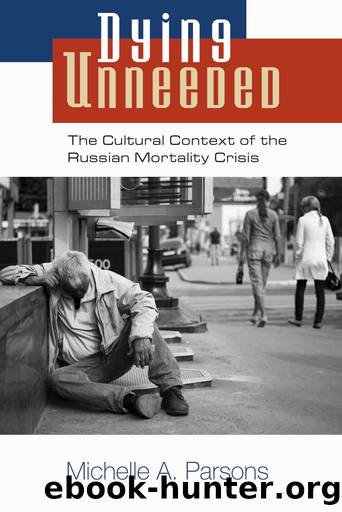Dying Unneeded by Michelle A. Parsons

Author:Michelle A. Parsons [Parsons, Michelle A.]
Language: eng
Format: epub
Tags: Social Science, Gender Studies, LGBTQ+ Studies, Gay Studies
ISBN: 9780826503541
Google: C7wpEAAAQBAJ
Publisher: Vanderbilt University Press
Published: 2021-04-30T03:19:59+00:00
CHAPTER 6
Mortality
The historical divergence in life expectancy between Eastern and Western Europe since the 1960s has been called the East-West divide (Và gerö and Illsley 1992). Whereas life expectancy in the West continued to steadily improve, in the East it remained the same or worsened. Figure 1 shows three former Eastern bloc countriesâ male life expectancies against that of France and the United States from 1960 through 2011. Life expectancy in the United States steadily increased by almost ten years to seventy-nine years. In France, it increased by twelve years to eighty-two years. Generally, male life expectancies in the East and West differed by no more than five years in the 1960s. These differences grew larger until the mid-1990s, when male life expectancies in the East began a slight recovery. Likewise, differences in female life expectancies (see Figure 2) widened between the East and West from the 1960s to the 1990s, when the gap begins to decrease slightly. As much as the general pattern of an East-West divide holds, the Russian Federation, represented by a thicker line, is clearly distinct from the Czech Republic and Romania, which roughly represent the range of life expectancies among Eastern bloc countries over this time period. Russian life expectancies are strikingly lower and more volatile. Russiaâs life expectancies are lowest and have not recovered as much. In 2011 male life expectancy in France was more than fifteen years longer than in Russia; female life expectancy was ten years longer.
As might be expected, looking at selected countries of the former Soviet Union (Figures 3 and 4), the Russian Federation data are not as distinct (note that the values on the vertical axes have changed). Among many of these former Soviet Union countries, life expectancy improved from 1985 to 1987. This is widely attributed to Gorbachevâs antialcohol campaign and, less frequently, to the reforms of perestroika, which some have surmised may have âinspired hopes for a better futureâ (Notzon et al. 1998, 795; Watson 1995). Menâs life expectancy suffered a precipitous drop in the early 1990s in most of the former western Soviet republics (not all of them shown). The Georgian data plateaued during this time period, but Armenia represents the only real exception to the trend. The data are more complicated for womenâs life expectancy, but again most countries registered substantial declines in the early 1990s. Nonetheless, only in the Baltics (Latvia, Lithuania, and Estonia) and the Ukraine did the declines approach those of the Russian Federation (Latvia and the Ukraine are shown in Figures 3 and 4). The sex difference in Russian life expectancies reached its greatest measure in the early 1990s. In 1992 womenâs life expectancy exceeded menâs by ten years; in 1994 it exceeded menâs by fourteen years.
Download
This site does not store any files on its server. We only index and link to content provided by other sites. Please contact the content providers to delete copyright contents if any and email us, we'll remove relevant links or contents immediately.
Cecilia; Or, Memoirs of an Heiress — Volume 1 by Fanny Burney(32438)
Cecilia; Or, Memoirs of an Heiress — Volume 2 by Fanny Burney(31875)
Cecilia; Or, Memoirs of an Heiress — Volume 3 by Fanny Burney(31858)
The Great Music City by Andrea Baker(31516)
We're Going to Need More Wine by Gabrielle Union(18972)
All the Missing Girls by Megan Miranda(15590)
Pimp by Iceberg Slim(14398)
Bombshells: Glamour Girls of a Lifetime by Sullivan Steve(13978)
Talking to Strangers by Malcolm Gladwell(13232)
Norse Mythology by Gaiman Neil(13211)
Fifty Shades Freed by E L James(13162)
For the Love of Europe by Rick Steves(13095)
Mindhunter: Inside the FBI's Elite Serial Crime Unit by John E. Douglas & Mark Olshaker(9206)
Crazy Rich Asians by Kevin Kwan(9171)
The Lost Art of Listening by Michael P. Nichols(7411)
Enlightenment Now: The Case for Reason, Science, Humanism, and Progress by Steven Pinker(7240)
The Four Agreements by Don Miguel Ruiz(6637)
Bad Blood by John Carreyrou(6558)
Weapons of Math Destruction by Cathy O'Neil(6151)
